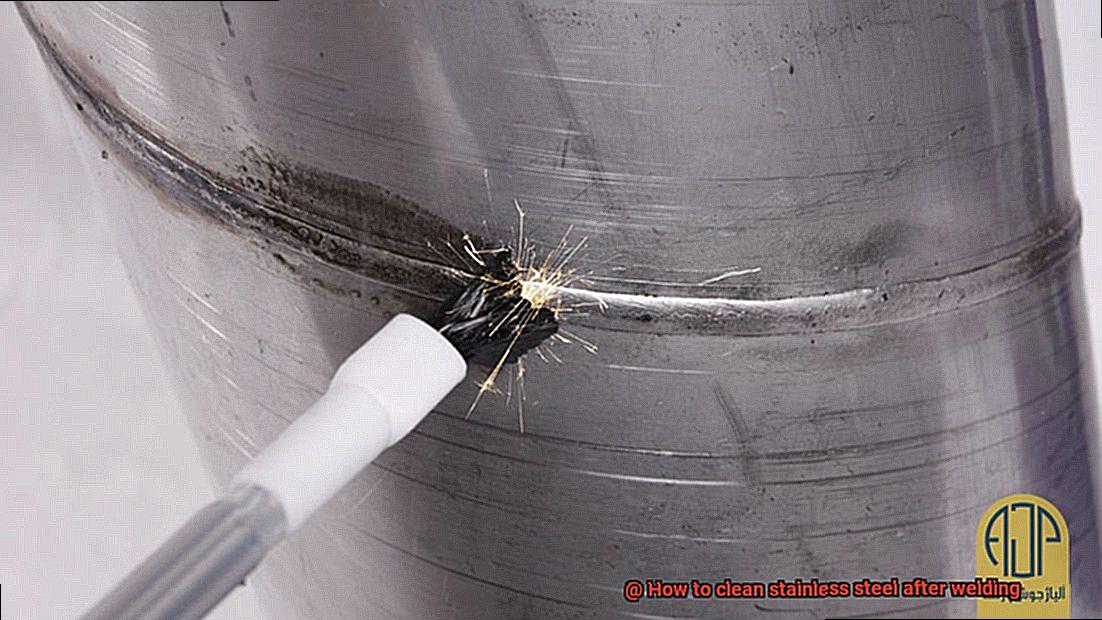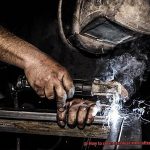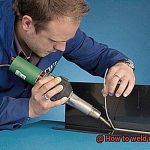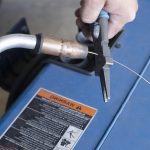Are you curious about how to clean stainless steel after welding? Welding is a crucial step in creating stainless steel products and structures. However, it can leave unwanted marks and discoloration on the surface of the material.
These blemishes can compromise the appearance and durability of your stainless steel, making it susceptible to rust and other damage. That’s why it’s essential to learn how to properly clean stainless steel after welding.
Cleaning stainless steel after welding requires specific techniques and equipment to ensure that the process is safe and doesn’t harm the material. This involves identifying the type of stainless steel you’re working with, selecting appropriate cleaning products, and using proper cleaning methods.
From mechanical degreasing to chemical deposition and electrochemical cleaning, there are several steps involved in cleaning stainless steel after welding. In this blog post, we’ll delve into the various methods for cleaning stainless steel after welding.
We’ll equip you with the necessary tools and skills to clean and maintain your stainless steel equipment and buildings effectively. Additionally, we’ll share tips and best practices to help you achieve a polished finish on your stainless steel surfaces seamlessly.
So if you want to know how to keep your stainless steel looking its best after welding, keep reading.
How to Clean Stainless Steel After Welding
Contents
Step 1: Removing Visible Debris and Slag
To ensure a pristine and durable finish, the first and foremost step is to remove any visible debris and slag from the surface. This can be accomplished using a wire brush, grinding wheel, or sandpaper depending on the severity of the debris.
Remember, any leftover debris or slag can lead to corrosion and rusting of the weld, ultimately affecting its quality and longevity. If you’re using a wire brush or grinding wheel, make sure you use protective gear such as gloves and safety glasses for your own safety.
Use the brush or wheel in a back-and-forth motion over the weld until all visible debris and slag are removed. For sandpaper, apply it in a circular motion with light pressure.
Start with coarser grits if heavier debris needs to be removed, then move on to finer grits for a smoother finish. Once all visible debris and slag have been removed, use a clean cloth or paper towel to wipe down the area to remove any remaining dust or particles.
This will ensure that the next cleaning steps are effective in removing any other contaminants from the surface of the stainless steel. In summary, removing visible debris and slag is crucial for maintaining the quality of your stainless steel welds.
Step 2: Degreasing the Surface
Degreasing a stainless steel surface after welding is like giving it a thorough sanitization to guarantee proper healing and long-lasting results, just like disinfecting a wound.
During the welding process, oils, greases, and other substances can accumulate on the metal’s surface, similar to bacteria on a wound. To remove these substances, you’ll need high-quality solvents like acetone, isopropyl alcohol, or mineral spirits that are highly effective at dissolving oils and greases, leaving behind a pristine and dry surface.
Before applying the solvent, it’s crucial to remove any visible debris or loose particles from the surface using wire brushes or sandpaper. This step guarantees that the solvent can penetrate deeply into all areas of the surface and effectively remove contaminants.
To begin degreasing, pour a small amount of solvent onto a clean cloth or rag and wipe down the entire surface of the metal. Make sure to pay special attention to any areas where grease or oil may have accumulated more than others.
Repeat this procedure as many times as needed until all visible contaminants are gone. Just like closing a wound after disinfecting, it’s vital to move on to the next step in the cleaning process immediately.
This will prevent new contaminants from settling on the surface and ensure that your stainless steel weld is strong and shiny for years to come.
Step 3: Removing Oxidation and Discoloration
Cleaning stainless steel after welding requires precision and the right tools to achieve a picture-perfect finish.
One essential step in this process is removing oxidation and discoloration, as they can mar the appearance of your stainless steel weld. Oxidation occurs when the metal surface reacts with oxygen, forming rust or corrosion.
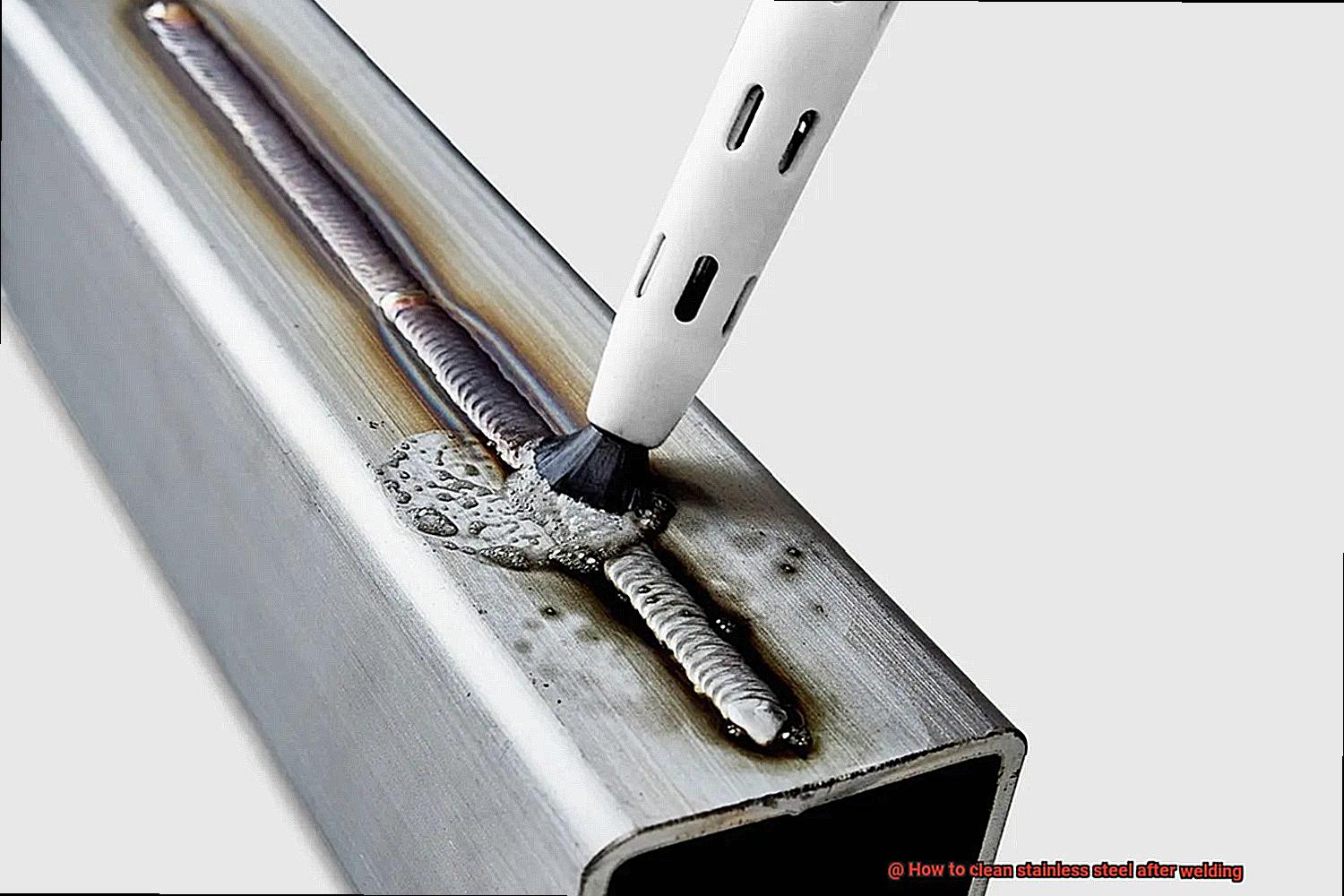
Meanwhile, discoloration is caused by heat from welding, leaving behind unappealing stains. But don’t worry – there are several methods for removing these blemishes and restoring your stainless steel’s shine.
One effective treatment is using an acidic solution such as vinegar or citric acid. These solutions dissolve rust and discoloration, leaving your metal surface smooth and shiny.
Simply soak a cloth or sponge in the solution and apply it to the affected area. Alternatively, a paste made from baking soda and water can be used to scrub away discoloration.
Another option is using specialized stainless steel cleaners designed to remove rust and stains without damaging the metal surface. While these cleaners require some scrubbing, they will leave your stainless steel looking brand new.
However, prevention is key in maintaining the longevity of your stainless steel welds. Avoid exposing them to moisture and humidity, and use protective coatings or sealants to prevent rust formation.
Step 4: Applying a Passivation Solution
Applying a passivation solution is a crucial step in maintaining the integrity of your metal and preventing unsightly blemishes caused by oxidation and discoloration.
So, what exactly is passivation? Think of it like applying sunscreen before heading to the beach.
Just as sunscreen shields your skin from harmful UV rays, passivation creates a protective oxide layer on the surface of your stainless steel to prevent further corrosion or rusting. This is particularly important for stainless steel, which can be quite susceptible to rust if not adequately maintained.
To apply a passivation solution, start by cleaning the surface of any contaminants or debris using a mild detergent or solvent and a clean cloth. Once the surface is clean, you can apply the passivation solution using a spray bottle, brush or immersion method.
There are several types of passivation solutions available, including citric acid, nitric acid, and phosphoric acid. Citric acid is a popular choice because it is less toxic than other acids and can be used at lower temperatures.
Nitric acid is also commonly used but requires careful handling due to its corrosive nature. After applying the passivation solution, rinse the surface thoroughly with water and dry it with a clean cloth.
This will ensure that any remaining solution is removed and prevent further corrosion. Overall, applying a passivation solution is an essential step in maintaining the appearance and integrity of your stainless steel after welding.
Different Methods for Cleaning Stainless Steel After Welding
Cleaning stainless steel after welding is just as important as washing your car after a long drive – it keeps it looking its best and performing at its peak for years to come. There are three different methods for cleaning stainless steel after welding: mechanical cleaning, chemical cleaning, and electrochemical cleaning.
Think of them like various cleaning products in your cleaning arsenal – each has its unique benefits and uses. Mechanical cleaning involves using abrasive materials such as sandpaper, wire brushes, or grinding wheels to remove oxidation, discoloration, or any other impurities left after welding.
It’s like scrubbing a dirty dish with a scouring pad – effective but time-consuming and labor-intensive. However, if done correctly, it results in a smooth finish that looks brand new.
Chemical cleaning involves using chemical solutions such as pickling pastes or acids to dissolve impurities left after welding. It’s like using a powerful cleaning agent to tackle tough stains on your favorite shirt.
This method is more efficient than mechanical cleaning as it can reach areas that may be difficult to reach manually. However, caution should be taken as some chemicals can be hazardous to handle and may corrode the stainless steel if not used correctly.
Electrochemical cleaning uses an electric current to remove impurities from the surface of the stainless steel. It’s like using an electric toothbrush to remove plaque from your teeth – fast and efficient but requires specialized equipment and expertise.
This method is quick and can result in a uniform finish. Regardless of the method used, make sure to rinse the stainless steel thoroughly after cleaning to remove any residue left behind.
This helps prevent discoloration or corrosion from occurring over time – just like rinsing dishes after washing them. In conclusion, choosing the right method for cleaning stainless steel after welding is critical in maintaining its integrity and longevity.
Mechanical, chemical, and electrochemical cleaning are all viable options – just remember to choose the correct method based on the type of weld and desired finish.
Tips for Maintaining a Professional Finish
Thoroughly Cleaning the Surface
Before and after welding, it’s crucial to have a clean surface. Whether it’s rubble, dirt, or grease, make sure to get rid of any contaminants that may have accumulated during the welding process.
Think of it like washing your car before applying wax; starting with a clean slate ensures that the end result stands out like a diamond. To do this, use a wire brush or grinder with a wire wheel attachment.
Afterwards, use a degreaser to remove oil or grease that may have accumulated on the surface.
Choosing the Right Cleaning Agent
Not all cleaning agents are created equal, especially when it comes to stainless steel. Acid-based cleaners such as citric acid or phosphoric acid are often recommended for removing any discoloration or oxidation that may occur during welding.
However, it’s essential to use these products with care and follow the manufacturer’s instructions closely.
Also, don’t forget to wear appropriate protective gear, such as gloves and safety glasses.
Thoroughly Drying the Surface
To prevent water spots or stains from forming, make sure to completely dry the surface after cleaning.
Moisture on stainless steel will lead to rusting and corrosion over time, so it’s important to ensure that the surface is completely dry before moving ahead. For this purpose, you can use a microfiber cloth or soft towel.
Application of a Protective Coating
Prevent future rusting or corrosion by applying a protective coating such as clear lacquer or wax after cleaning. This will help seal the surface and prevent moisture from entering the area.
Think of it like applying sunscreen on your skin; it helps prevent damage caused by the elements.
Handling Stainless Steel Carefully
To prevent scratching or damaging the surface, handle stainless steel carefully after welding. Using protective gloves and gear can prevent any accidental harm.
It’s kind of like handling delicate china; you need to be careful not to drop or bump it in order to keep it looking pristine.
Also Read: How to clean stainless steel after welding?
Conclusion
In conclusion, keeping your stainless steel products and buildings looking their best requires proper cleaning after welding.
But fear not, with the right techniques and equipment, you can ensure a safe and effective cleaning process that won’t damage the material. Removing visible oil and slag from the surface of your stainless steel after welding involves several steps, including mechanical, chemical, and electrochemical cleaning methods.
The choice of method will depend on the type of weld and desired finish. To achieve a professional finish on your stainless steel after welding, it’s crucial to follow a few key steps:
- Thoroughly clean the surface before and after welding
- Select the appropriate cleaning agent for your needs
- Dry the surface completely to avoid water spots
- Apply a protective coating to prevent corrosion or staining
- Handle with care
By following these guidelines and best practices for cleaning stainless steel after welding, you can maintain your equipment and buildings in top condition for years to come.
